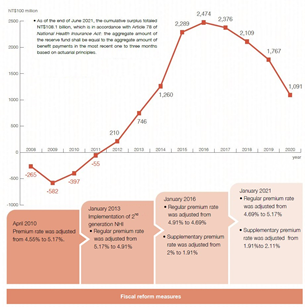Consolidating health insurances from Taiwan's various social insurance systems since 1995, the NHI has been operated under financial self-sufficiency and pay-as-you-go principles. At present, the system derives its incomes mainly from premiums paid by the insured, employers, and the government, and the system also receives some supplementary incomes from premium overdue charges, lottery earnings, and tobacco surcharges.
As Taiwan's overall environment and demographic structure have changed, medical expenses have increased at a faster rate than premium income. Apart from acting vigorously to conserve funds and develop new sources of income, NHIA raised the premium rate in 2002, 2010 and 2021. Bearing in mind the insured's ability to pay, it has also made gradual adjustments to the upper and lower limits, and intervals of the payroll bracket table used to calculate insurance premiums, and the cap on the number of dependents for whom premiums are collected. Military personnel, civil servants and teachers, whose premiums were once calculated on their base salaries, now pay premiums based on their total compensation. A supplemental premium is now collected on six types of income not previously included in premium calculations, and the lower limit of the government's contribution is now clearly specified. All of these measures have served to stabilize NHI's finances and maintain the NHI system's operation and balance.
Following the implementation of the 2nd generation NHI in 2013, an income/expenditure linkage mechanism was established, and the NHI Supervisory Committee (responsible for management of income) and the NHI Medical Expenditure Negotiation Committee (responsible for negotiating expenditures) were merged as the National Health Insurance Committee. This committee, which comprises the insured, employers, insurance medical service providers, experts, scholars, impartial public figures, and representatives of relevant agencies, is responsible for reviewing annual insurance premium rate under the approved amount of annual medical payments (Global budget) and reporting the proposed premium rate to Ministry of Health and Welfare, which further requires Executive Yuan's approval. It is hoped that the revenue/ expenditure linkage mechanism will ensure long-term financial stability
The NHI system first began encountering shortfalls since 1998, and the cumulative budget had its first shortfall at the end of March 2007. An increase in the premium rate in April 2010 helped the cumulative budget shortfall shift to a surplus in February 2012. The launch of the new 2nd Generation NHI system has increased the collection of supplementary premiums and the government's minimum contribution to premiums, which overall brought about improvement of financial condition. However, the medical expenditure is far higher than the growth rate of premium revenue, which resulted in the increase of shortfalls since 2017. As a result, the premium rate has been adjusted since January 2021. As of June 2021, there is an accumulated surplus of NT$108.1 billion.
Chart Cumulative Balance before and after the 2nd Generation NHI


